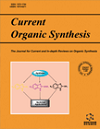-
oa Editorial [Hot Topic: Organic Chemistry Meets with Molecular Imaging (Guest Editor: Zhen Cheng)]
- Source: Current Organic Synthesis, Volume 8, Issue 4, Aug 2011, p. 472 - 472
-
- 01 Aug 2011
- Previous Article
- Table of Contents
- Next Article
Abstract
Medical imaging has been used for disease diagnosis as well as physiological assessment for over one hundred years since the discovery of X-rays by Professor Roentgen. Thanks to the ever evolving fields of physics and medicine, the past century has witnessed the rapid development and advancement of many powerful imaging modalities such as X-ray, nuclear imaging, ultrasound, computed tomography (CT) and magnetic resonance imaging (MRI). When it comes to the field of synthetic chemistry, however, despite occasional uses of some contrast agents and radioactive chemicals to help visualize diseased organs and tissues, organic chemistry has had a rather small intersection with conventional medical imaging technology and science. With the recent rising of molecular imaging research, modern medical imaging are expected to provide unforeseen opportunities to reveal physiological functions and disease pathologies at the fundamental molecular level and thus make sweeping changes in medical diagnosis, treatment and management. In order to fulfill such expectations to non-invasively image living subjects, numerous molecular probes have been designed, synthesized and studied by exploring many different molecular platforms across the chemical space, which include small molecules, peptides, peptidomimetics, proteins, organic polymers, nanoparticles and more. Organic synthesis has since become highly important for rapid and successful preparations of many novel molecular probes and therefore virtually indispensable to meet the ever greater needs of molecular imaging applications. This special issue is thus intended to i) invite attentions from synthetic organic chemistry community to the field of molecular imaging and imaging probe development; and ii) highlight the current trends in some areas in molecular probe development such as bioluminescence and fluorescence optical imaging, magnetic resonance imaging (MRI), positron emission tomography (PET), and single photon emission computed tomography (SPECT). As we all know, organic chemistry has long played a pivotal role in pharmaceutical industry and numerous synthetic techniques have been discovered and applied in the process of drug discovery. It is our sincere hope that by applying the existing strategies of synthetic organic chemistry and also exploring new approaches for developing molecular probes, organic chemistry will become a major contributor to the modern molecular imaging. Practiced and refined for centuries since Professor Woehler debunked Vitalism, organic chemistry has been widely recognized as a specialized form of art. On the other hand, barely emerged in the beginning of the twenty-first century and full of promises, molecular imaging is now calling for a new stretch of imagination. By combining art and imagination we can expect to improve and advance imaging of human health and disease to an unprecedented level. Last but not least, as a guest editor for this special issue, I would like to take this opportunity to thank my colleagues for their excellent contributions. I would also like to thank the referees for their invaluable insights. My earnest appreciations also go to Ms. Humaira Hashmi (Sr. Manager Publications, Current Organic Synthesis) and Ms. Maria Baig (Assistant Manager Publications, Current Organic Synthesis), both of whom helped tremendously to put this issue together.


